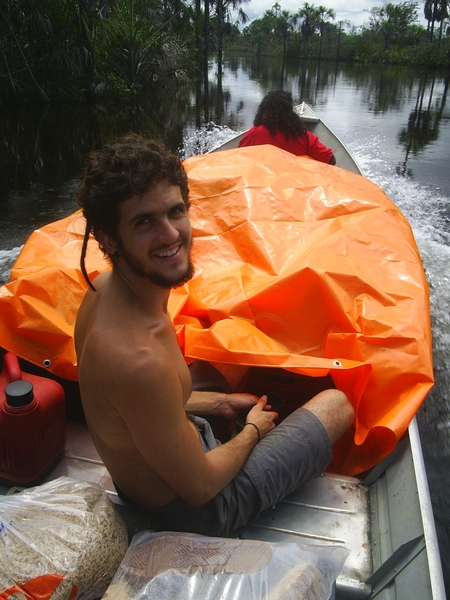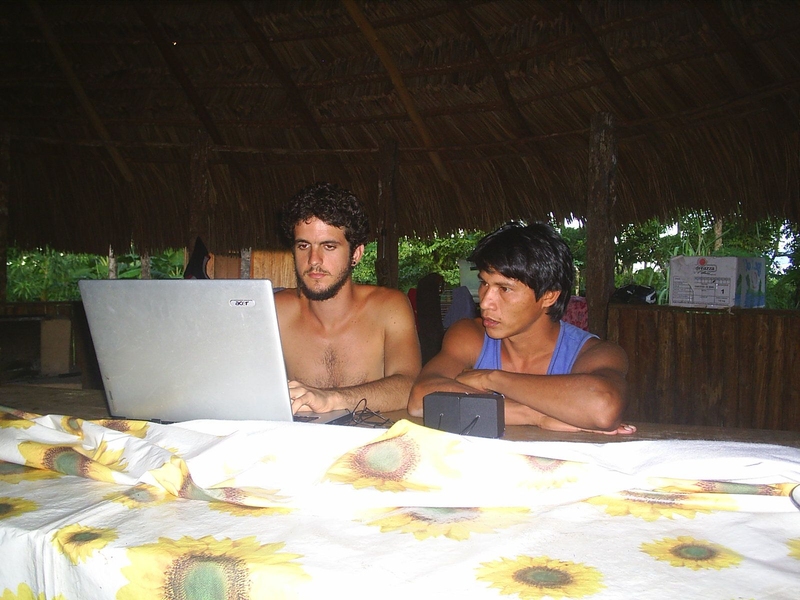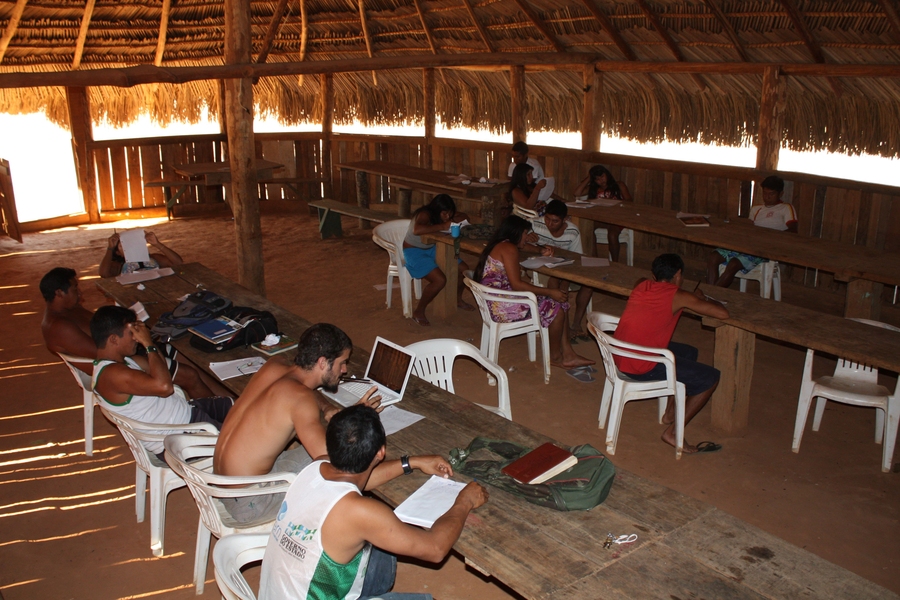Wandering through his university’s library in São Paulo one day in 2002, Rafael Nonato noticed a book titled “Language.” Curious, he pulled it off the shelf.
The book was written in 1921 by a linguist named Edward Sapir, who did work on Native American languages. “It’s this very interesting book; he discusses the possible relationships between language and culture. I thought, ‘Wow, this is really cool!’” Nonato says.
Then halfway through a computer engineering degree, Nonato found a linguistics program at the nearby State University of Campinas and began coursework there. Now, as a PhD student in linguistics at MIT, Nonato studies the indigenous Brazilian language Kĩsêdjê (keen-seh-jay), dividing his time between a Kĩsêdjê village on the outskirts of the Amazon rainforest and MIT, where he puzzles out the structure of the language.
Into the field
Nonato’s introduction to fieldwork and to MIT occurred in his second year as an undergraduate in linguistics, when some MIT professors visited Campinas for a summer-school session. In a course on fieldwork methods, professor of linguistics Norvin Richards demonstrated linguistic fieldwork to the students by interviewing a native speaker of an indigenous Brazilian language.
“It was as though he had this black box that was actually a person that speaks two languages, and he was asking how to say this and that and trying to establish paradigms,” Nonato recounts. “I decided I wanted to do that.”
Inspired, Nonato called a public phone in an indigenous Bororo village, spoke with some schoolteachers, and soon began fieldwork in the village. Though a missionary had previously documented the language, Nonato started from scratch, only reading that account after he had written his own.
“When you’re doing fieldwork, sometimes it’s easy to have expectations, especially if you’re dealing with theory,” Nonato explains. “You sometimes want to find that this exotic language that you’ve been working on has this exotic property that is going to allow you to write this revolutionizing paper, and sometimes it doesn’t. So you shouldn’t have these expectations.”
Nonato completed his account of the Bororo language for his master’s work, then applied and was accepted for PhD work at MIT, where he began to study the Kĩsêdjê language. Though Kĩsêdjê and Bororo are both indigenous Brazilian languages and are spoken in regions that are geographically close, Nonato says, they have the same degree of linguistic separation as English and Portuguese.
Unlocking Kĩsêdjê
Today, when Nonato goes to the Kĩsêdjê village for fieldwork, he stays for up to two months. Each day, he sits with two bilingual men from the village, methodically asking how to say various sentences in Kĩsêdjê.
“It’s not just how to say anything; I will look for paradigms,” Nonato says. For example, he explains, “If I want to know if there’s verbal agreement, I will keep the verb constant and I will just change the subject.”
Over time, Nonato has gained insight into the workings of Kĩsêdjê. In structure, it is more similar to Japanese than to English; the verb always comes at the end of the sentence, for example. There are two different words to express “we” — one if the speaker is including the person he is talking to, and another if he is not. Among his many observations, Nonato has focused on a few that he believes have theoretical significance.
“In their language they have at least two words for ‘and,’” Nonato says. “One of them they use when you’re talking about the same person in both sentences. They would say a different word if the subject switched.”
The two words for “and,” nhy and ne, solve some potential ambiguities. In English, if you were to say, “Joe went running with John, and he was tired,” there would be no way to know whether Joe or John was tired. In Kĩsêdjê, it would be clear from which “and” was used. However, the rule doesn’t always hold.
“There are contexts in which the difference gets neutralized,” Nonato says. “My idea is these contexts are telling us something about what mechanism the language uses for performing this comparison, because whatever it is, it’s something that can’t function in these certain contexts.”
The exceptions to the “and” rule are perplexing, but are actually useful, Nonato says. “If you only see a system that works neatly, you don’t really know how it works,” he explains. “When you see some break points in the system, you have more clues that restrict the kind of theory you can propose for how the system works.”
One piece of the puzzle
Discovering a truly bizarre and exotic language was once the dream of many linguists; that is no longer true, Nonato says. “Noam [Chomsky, Institute Professor Emeritus at MIT] came up with the idea that languages are just parameterizations of the brain, that there is actually a framework that all languages share,” he explains.
Now, Nonato hopes to fit Kĩsêdjê into the larger puzzle of the world’s languages. “Partly what I’m trying to do is look at seemingly exotic parts of Kĩsêdjê and frame it in such a way that it’s just like other languages,” he says. “I’m trying to come up with a theory that doesn’t make this language seem bizarre.”
If linguists are able to piece together enough of the language puzzle, the picture that emerges could provide insight into the roots of language. “By studying and comparing languages, we may be able to understand the basic brain-based structures that all languages share,” Nonato says.
The book was written in 1921 by a linguist named Edward Sapir, who did work on Native American languages. “It’s this very interesting book; he discusses the possible relationships between language and culture. I thought, ‘Wow, this is really cool!’” Nonato says.
Then halfway through a computer engineering degree, Nonato found a linguistics program at the nearby State University of Campinas and began coursework there. Now, as a PhD student in linguistics at MIT, Nonato studies the indigenous Brazilian language Kĩsêdjê (keen-seh-jay), dividing his time between a Kĩsêdjê village on the outskirts of the Amazon rainforest and MIT, where he puzzles out the structure of the language.
Into the field
Nonato’s introduction to fieldwork and to MIT occurred in his second year as an undergraduate in linguistics, when some MIT professors visited Campinas for a summer-school session. In a course on fieldwork methods, professor of linguistics Norvin Richards demonstrated linguistic fieldwork to the students by interviewing a native speaker of an indigenous Brazilian language.
“It was as though he had this black box that was actually a person that speaks two languages, and he was asking how to say this and that and trying to establish paradigms,” Nonato recounts. “I decided I wanted to do that.”
Inspired, Nonato called a public phone in an indigenous Bororo village, spoke with some schoolteachers, and soon began fieldwork in the village. Though a missionary had previously documented the language, Nonato started from scratch, only reading that account after he had written his own.
“When you’re doing fieldwork, sometimes it’s easy to have expectations, especially if you’re dealing with theory,” Nonato explains. “You sometimes want to find that this exotic language that you’ve been working on has this exotic property that is going to allow you to write this revolutionizing paper, and sometimes it doesn’t. So you shouldn’t have these expectations.”
Nonato completed his account of the Bororo language for his master’s work, then applied and was accepted for PhD work at MIT, where he began to study the Kĩsêdjê language. Though Kĩsêdjê and Bororo are both indigenous Brazilian languages and are spoken in regions that are geographically close, Nonato says, they have the same degree of linguistic separation as English and Portuguese.
Unlocking Kĩsêdjê
Today, when Nonato goes to the Kĩsêdjê village for fieldwork, he stays for up to two months. Each day, he sits with two bilingual men from the village, methodically asking how to say various sentences in Kĩsêdjê.
“It’s not just how to say anything; I will look for paradigms,” Nonato says. For example, he explains, “If I want to know if there’s verbal agreement, I will keep the verb constant and I will just change the subject.”
Over time, Nonato has gained insight into the workings of Kĩsêdjê. In structure, it is more similar to Japanese than to English; the verb always comes at the end of the sentence, for example. There are two different words to express “we” — one if the speaker is including the person he is talking to, and another if he is not. Among his many observations, Nonato has focused on a few that he believes have theoretical significance.
“In their language they have at least two words for ‘and,’” Nonato says. “One of them they use when you’re talking about the same person in both sentences. They would say a different word if the subject switched.”
The two words for “and,” nhy and ne, solve some potential ambiguities. In English, if you were to say, “Joe went running with John, and he was tired,” there would be no way to know whether Joe or John was tired. In Kĩsêdjê, it would be clear from which “and” was used. However, the rule doesn’t always hold.
“There are contexts in which the difference gets neutralized,” Nonato says. “My idea is these contexts are telling us something about what mechanism the language uses for performing this comparison, because whatever it is, it’s something that can’t function in these certain contexts.”
The exceptions to the “and” rule are perplexing, but are actually useful, Nonato says. “If you only see a system that works neatly, you don’t really know how it works,” he explains. “When you see some break points in the system, you have more clues that restrict the kind of theory you can propose for how the system works.”
One piece of the puzzle
Discovering a truly bizarre and exotic language was once the dream of many linguists; that is no longer true, Nonato says. “Noam [Chomsky, Institute Professor Emeritus at MIT] came up with the idea that languages are just parameterizations of the brain, that there is actually a framework that all languages share,” he explains.
Now, Nonato hopes to fit Kĩsêdjê into the larger puzzle of the world’s languages. “Partly what I’m trying to do is look at seemingly exotic parts of Kĩsêdjê and frame it in such a way that it’s just like other languages,” he says. “I’m trying to come up with a theory that doesn’t make this language seem bizarre.”
If linguists are able to piece together enough of the language puzzle, the picture that emerges could provide insight into the roots of language. “By studying and comparing languages, we may be able to understand the basic brain-based structures that all languages share,” Nonato says.











